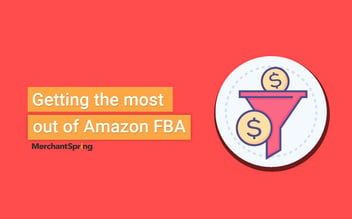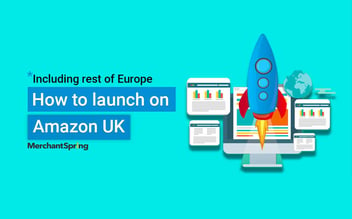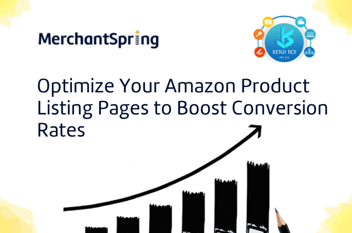Amazon Conversion Rate Optimisation: 5 tips to increase your sales
Intro
The first thing you need to understand about improving a conversion rate on Amazon is that Amazon refers to it as the Unit Session Percentage. It’s a little different from a typical ecommerce conversion rate and it’s worth explaining.
eCommerce Conversion Rate = # of sales / # of sessions
Amazon’s Unit Session Percentage = # of units sold / # of sessions
This means that Amazon also takes into consideration the number of units sold – and, consequently, the average order value – and not just the fact that there was a sale.
The Unit Session Percentage is one of a handful of metrics used by Amazon to help shoppers find the products that are most likely to satisfy their needs in the quickest time possible.
The average Unit Session Percentage is 12,3%, although it varies from category to category. However, if you’re below that benchmark, some of your competitors might have better USPs than you and your listings are suffering.
Ultimately, a bad conversion rate breeds even worse conversion rates. So it’s important that you try these tips to improve your Amazon conversion rate/unit session percentage.
Listing Optimisation
Product Titles
Titles are one of the first things buyers see and makes them decide whether to click or not. The goal here is to provide detailed and accurate information, so as not to mislead shoppers into clicking (and then abandoning the page). Amazon actually created a page with product title guidelines and examples, so be sure to follow their recommendations.
Product images
Real, detailed and professional product images are the fastest way to reduce a buyer’s risk perception. If they feel like they know exactly what they’ll be getting, they will be happy to buy. Use your image gallery to show customers:
- Who it’s for
- How it’s used
- How it works (when applicable)
- Contents of the package
- Measurements and swatches (when applicable)
Product Variations
If you’re splitting the same product into separate listings due to certain differences, like size, color or version, you’re making it harder for customers to find the right product. Consolidate all product variations into one single listing and watch your conversion rate increase.
Bullet Points
Bullet points should summarise the main information that buyers are looking for. Don’t forget that users on Amazon are already highly motivated to purchase, have done most of their research and are just looking for the right option. Bullet points are there to make them understand quickly that they’ve found the right product.
A+ Content
According to Amazon, product listings with A+ Content have 10% more sales than those without. Simply put, with A+ Content, you can display eye-catching banners, show your product from every angle and add even more rich content.
If your competitors have similar products on offer, this is the best way to differentiate yourself and enable shoppers to buy the item from you with more confidence.
Another benefit of using A+ Content is ranking higher up in the organic search results. Coupling that with more appealing and specific content will surely boost conversions.
Running Split Tests
Once you’ve optimised your listings, it’s a good idea to run A/B or split tests. This is how you’ll know for sure that you’re running the best possible listing. An app like Splitly asks you to create different variations of the same listing, with different prices, features, images, keywords and content.
Then it automatically rotates the listing variations for some time, allowing buyers to interact and buy. When it arrives at a statistically sound results, it publishes the winning listing – the one that is more likely to deliver a good conversion rate.
Running Promotions
The quickest way to get your conversion rate up will be to run promotions. Who doesn't love a good deal? So after arriving at the best version of your listing, get those sales up with some promotions like:
- Money Off – Give a percentage discount when the customer buys at least X quantity of items or spends at least X amount of money.
- Free Shipping – offer free shipping when the customer meets a certain requirement, like buying within a time-frame, reaching an order value of at least X, buying only eligible products, etc.
- Buy One, Get One – Eligible customers get one or more items for free when one or more are purchased.
As with the listings, it’s always a good idea to test and see which type of promotion will drive more conversions.
Amazon PPC
Amazon PPC will put your listings at the top spot of the rankings and, if you’ve played your cards right, your conversion rate will improve quickly and steadily. In order to run a successful PPC campaign, you will need to be 100% certain that you’re targeting the right keywords. Otherwise, you’ll be appearing in non-relevant search results and getting views that won’t convert.
Tools to improve conversion rate
We’ve already talked about Splitly, a tool to help you automate split testing. Other helpful tools to increase Amazon conversion rates include features like:
- Detecting on page content lapses and automatically suggest listing optimisations – AMZ Tracker, AMZ Data Studio, Viral Launch, IOScout
- Repricing your listings automatically to increase share of the Buy Box – Feedvisor, Repricer Express, Bqool, Repricer
- Monitoring Seller Health and product performances across different platforms and international marketplaces – MerchantSpring
Conclusion
All of the optimisations that we mentioned today are about improving your customer’s buying experience and making sure we give them all the resources to make a good decision quickly.
This customer-centric approach is what has made Amazon the mammoth that it is today and they want to keep it that way. So be sure to align yourself with that approach and good things will follow.









Add a Comment